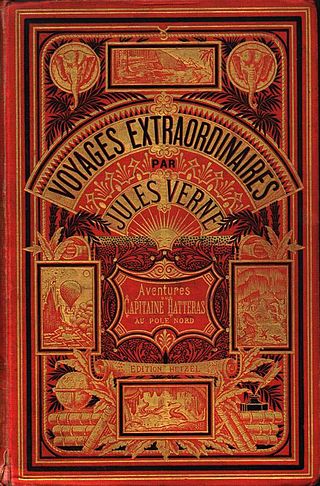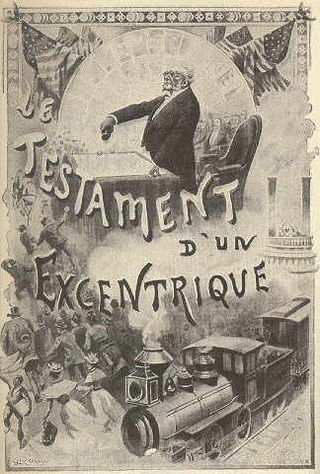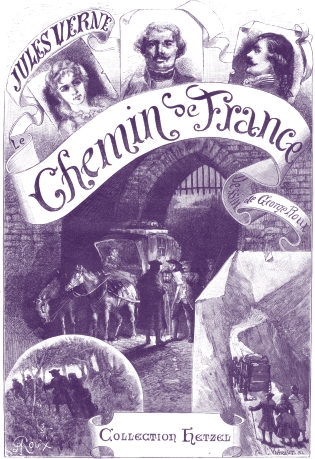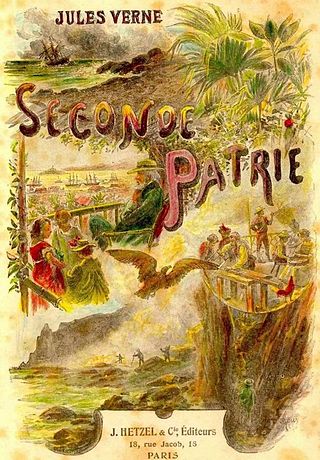
Twenty Thousand Leagues Under the Seas is a classic science fiction adventure novel by French writer Jules Verne.

The Mysterious Island is a novel by Jules Verne, published in 1875. The first edition, published by Hetzel, contains illustrations by Jules Férat. The novel is a crossover sequel to Verne's famous Twenty Thousand Leagues Under the Seas (1870) and In Search of the Castaways (1867–68), though its themes are vastly different from those books. An early draft of the novel, rejected by Verne's publisher and wholly reconceived before publication, was titled Shipwrecked Family: Marooned with Uncle Robinson, indicating the influence of the novels Robinson Crusoe and The Swiss Family Robinson. Verne developed a similar theme in his novel, Godfrey Morgan.

The Voyages extraordinaires is a collection or sequence of novels and short stories by the French writer Jules Verne.

Mathias Sandorf is an 1885 adventure book by the French writer Jules Verne first serialized in Le Temps in 1885. It employs many of the devices that had served well in his earlier novels: islands, cryptograms, surprise revelations of identity, technically advanced hardware and a solitary figure bent on revenge. Verne planned Mathias Sandorf as the Mediterranean adventure of his series of novels called Voyages extraordinaires. He dedicated the novel to the memory of Alexandre Dumas.

The Green Ray is a novel by the French writer Jules Verne published in 1882 and named after the optical phenomenon of the same name. It is referenced in a 1986 film of the same name by Eric Rohmer.

Clovis Dardentor is an 1896 fiction novel by French writer Jules Verne, written partly as a travel narrative. Compared to other Verne novels, it is a relatively unknown work.

Off on a Comet is an 1877 science fiction novel by French writer Jules Verne. It recounts the journey of several people carried away by a comet contacting the Earth. The comet passes by various bodies in the Solar System before returning the travelers to the Earth.

Two Years' Vacation is an adventure novel by Jules Verne, published in 1888. The story tells of the fortunes of a group of schoolboys stranded on a deserted island in the South Pacific, and of their struggles to overcome adversity. In his preface to the book, Verne explains that his goals were to create a Robinson Crusoe-like environment for children, and to show the world what the intelligence and bravery of a child were capable of when put to the test.

"A Drama in Mexico" is a historical short story by Jules Verne, first published in July 1851 under the title "L'Amérique du Nord, études historiques: Les Premiers Navires de la marine mexicaine."

Family Without a Name is an 1889 adventure novel by Jules Verne about the life of a family in Lower Canada during the Lower Canada Rebellion of 1837 and 1838 that sought an independent and democratic republic for Lower Canada. In the book, the two sons of a traitor fight in the Rebellion in an attempt to make up for the crime of their father.

Propeller Island is a science fiction novel by French author Jules Verne (1828–1905). It was first published in 1895 as part of the Voyages Extraordinaires. It relates the adventures of a French string quartet in Milliard City, a city on a massive ship in the Pacific Ocean, inhabited entirely by millionaires.

The Fur Country or Seventy Degrees North Latitude is an adventure novel by Jules Verne in The Extraordinary Voyages series, first published in 1873. The novel was serialized in Magasin d’Éducation et de Récréation from 20 September 1872 to 15 December 1873. The two-volume first original French edition and the first illustrated large-format edition were published in 1873 by Pierre-Jules Hetzel. The first English translation by N. D’Anvers was also published in 1873.
Reverend Lewis Page Mercier is known today as the translator, along with Eleanor Elizabeth King, of three of the best-known novels of Jules Verne: Twenty Thousand Leagues Under the Seas, From the Earth to the Moon, and Around the Moon. To avoid a conflict of interest with his position as chaplain, Mercier wrote under the pen names of Louis Mercier, MA (Oxon) and Mercier Lewis.

The Chase of the Golden Meteor is a novel by Jules Verne. It was one of the last novels written by the prolific French hard science fiction pioneer. The book, however, is seen as less an early example of hard science fiction than a social satire lampooning greed, monomania and vanity. Verne first wrote La Chasse au météore in 1901 and then rewrote it before his death, but it was only published in 1908, three years after the author's death, one of seven such posthumous novels.

The Will of an Eccentric is a 1900 adventure novel written by Jules Verne based on the Game of the Goose.

Kéraban the Inflexible is an adventure novel written by Jules Verne.

The Flight to France is an adventure novel written by Jules Verne about a fictional French Army Captain Natalis Delpierre, with a setting in the year 1792 just before the French Revolutionary Wars. Several English language editions were published with the subtitle, The Flight to France; or, The Memoirs of a Dragoon. A Tale of the Day of Dumouriez.

The Castaways of the Flag is an adventure novel written by Jules Verne. The two volumes of the novel were initially published in English translation as two separate volumes: Their Island Home and The Castaways of the Flag. Later reprints were published as The Castaways of the Flag.

"A Drama in the Air" is an adventure short story by Jules Verne. The story was first published in August 1851 under the title "Science for families. A Voyage in a Balloon" in Musée des familles with five illustrations by Alexandre de Bar. In 1874, with six illustrations by Émile-Antoine Bayard, it was included in Doctor Ox, the only collection of Jules Verne's short stories published during Verne's lifetime. An English translation by Anne T. Wilbur, published in May 1852 in Sartain's Union Magazine of Literature, marked the first time a work by Jules Verne was translated into the English language.

Jules Verne (1828–1905) was a French novelist, poet, and playwright. Most famous for his novel sequence, the Voyages Extraordinaires, Verne also wrote assorted short stories, plays, miscellaneous novels, essays, and poetry. His works are notable for their profound influence on science fiction and on surrealism, their innovative use of modernist literary techniques such as self-reflexivity, and their complex combination of positivist and romantic ideologies.



















